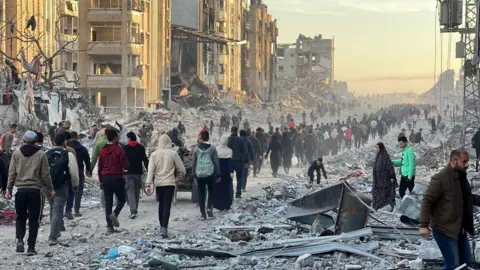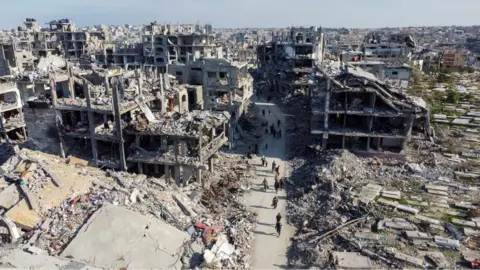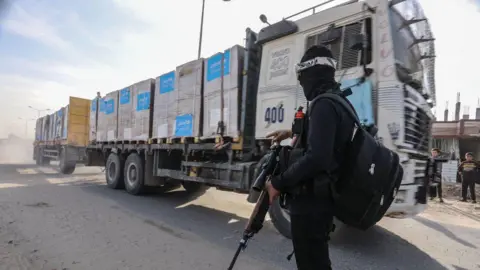
 Getty Images
Getty ImagesAs Palestinians took to the streets of Gaza to celebrate the ceasefire, the joy for many faded as they returned to their homes to be met with destruction.
In Jabaliya, a town in northern Gaza that is home to the Strip’s largest refugee camp, photos and videos shared by residents showed entire neighborhoods reduced to rubble.
“My two daughters and I were rescued from under the rubble of the house,” Dua Khalidi told BBC News after returning to the Faluja area of Jabaliya.
“The bodies of my husband, mother-in-law and sister-in-law have been buried under the rubble since October 9.”
The 28-year-old mother of two continued: “I just want their bodies so I can bury them with dignity.”
The Jabaliya camp, once home to more than 250,000 Palestinians, became the site of Israel’s largest and most violent military operation during the war, killing about 4,000 Palestinians, according to the Hamas-run Health Ministry.
Hussein Awda also returned to Jabaliya, recording his return journey from Gaza City.
The professional weightlifter, who represented Palestine in international competitions, lost 10 family members when the war began.
“The best thing that happened today is that, 100 days later, I was able to visit family members’ graves and pray for them,” he shared.
He also posted a video showing the damage to his three-storey home and the sports club he owns.
“Here I lost the people closest to me – my brother, my son, my source of livelihood. The war kills everything good in us.”
 Reuters
ReutersIn the southern city of Khan Younis, armed Hamas fighters drove through the streets and shouted slogans to cheering crowds, Reuters reported.
Hamas police officers in uniform have also been deployed in some areas after months of hiding from Israeli attacks.
Gaza City resident Ahmed Abu Aham, who has been taking refuge with his family in Khan Younis, told Reuters his hometown was “terrible”.
In the city, there are Experts say it suffered the worst damagepeople waving Palestinian flags and filming the scene with their mobile phones.
But the 40-year-old said that while a ceasefire might save lives, now was not the time to celebrate.
“We are in pain, deep pain, and it’s time for us to hug each other and cry,” he said.
Gazans are also moving to the southern city of Rafah, near the Egyptian border.
Mohammad Suleiman told BBC Arabic’s Gaza Lifeline: “Thank God, we received the news with joy and happiness that the ceasefire has come into effect.
“God willing, things will get better and we will return to Rafah. I hope every displaced person can return home safely.”
After Israel ordered the evacuation, many people fled the city and then began operations in the southern Gaza city.
In Rafah, Muhammad al-Jamal, a reporter for the Palestinian newspaper Al-Ayyam, reflected on his loss.
The houses were razed to the ground; everything was in ruins,” he said. “The chicken coops and fig trees where we shared the fruit are now a thing of the past. “
 Getty Images
Getty ImagesThe fragility of the ceasefire became apparent in the first hours.
The ceasefire finally came into effect after a three-hour delay, during which 19 Palestinians were reportedly killed in what Israel said were attacks against “terror targets.”
In the afternoon, Three Israeli female hostages return to Israel As part of the six-week first phase, 33 hostages will be released.
But people in Gaza remain concerned that the truce could falter again.








